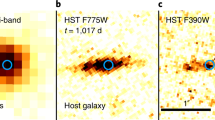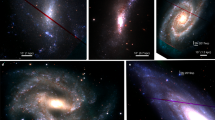Abstract
The discovery of the unusual supernova SN1998bw, and its possible association with the γ-ray burst GRB 9804251,2,3, provide new insights into the explosion mechanism of very massive stars and the origin of some classes of γ-ray bursts. Optical spectra indicate that SN1998bw is a type Ic supernova3,4, but its peak luminosity is unusually high compared with typical type Ic supernovae3. Here we report our findings that the optical spectra and the light curve of SN1998bw can be well reproduced by an extremely energetic explosion of a massive star composed mainly of carbon and oxygen (having lost its hydrogen and helium envelopes). The kinetic energy of the ejecta is as large as +(2–5)× 1052 erg, more than ten times that of previously observed supernovae. This type of supernova could therefore be termed ‘hypernova’. The extremely large energy suggests the existence of a new mechanism of massive star explosion that can also produce the relativistic shocks necessary to generate the observed γ-rays.
This is a preview of subscription content, access via your institution
Access options
Subscribe to this journal
Receive 51 print issues and online access
$199.00 per year
only $3.90 per issue
Buy this article
- Purchase on Springer Link
- Instant access to full article PDF
Prices may be subject to local taxes which are calculated during checkout



Similar content being viewed by others
References
Soffitta, P., Feroci, M. & Piro, L. IAU Circ. No. 6884 (1998).
Lidman, C. et al . IAU Circ.No. 6895 (1998).
Galama, T. J. et al . An unusual supernova in the error box of the γ-ray burst of 25 April 1998. Nature 395, 670–672 (1998).
Patat, F. & Piemonte, A. IAU Circ.No. 6918 (1998).
Filippenko, A. V. Optical spectra of supernovae. Annu. Rev. Astron. Astrophys. 35, 309–355 (1997).
Nomoto, K. et al . Acarbon-oxygen star as progenitor of the type Ic supernova 1994I. Nature 371, 227–229 (1994).
Iwamoto, K. et al . Theoretical light curves for the type Ic supernova SN 1994I. Astrophys. J. 437, L115–L118 (1994).
Iwamoto, K. et al . Light curve modeling of the type Ib/Ic supernova 1997ef. Astrophys. J. (submitted).
Arnett, W. D. Type I supernovae. I. Analytic solutions for the early part of the light curve. Astron. Astrophys. 253, 785–797 (1982).
Mazzali, P. A. & Lucy, L. B. The application of Monte Carlo methods to the synthesis of early-time supernovae spectra. Astron. Astrophys. 279, 447–456 (1993).
Paczyński, B. Are gamma-ray bursts in star-forming regions? Astrophys. J. 494, L45–L48 (1998).
Woosley, S. E. Gamma-ray bursts from stellar mass accretion disks around black holes. Astrophys. J. 405, 273–277 (1993).
Piran, T. in Some Unsolved Problems in Astrophysics (eds Bahcall, J. N. & Osriker, J. P.) 343–377 (Princeton Univ. Press, (1997)).
Kulkarni, S. R. et al . IAU Circ. No. 6903 (1998).
Baron, E., Young, T. R. & Branch, D. Astrophys. J. 409, 417–421 (1993).
Garnavich, P., Jha, S., Kirchner, R. & Challis, P. IAU Circ.No. 6798 (1997).
Richmond, M. W. et al . UBVRI photometry of the Type Ic SN 1994I in M51. Astron. J. 111, 327–339 (1996).
Thielemann, F.-K., Nomoto, K. & Hashimoto, M. Core-collapse supernovae and their ejecta. Astrophys. J. 460, 408–436 (1996).
Nakamura, T., Umeda, T., Nomoto, K., Thielemann, F.-K. & Burrows, A. Nucleosynthesis in type II supernovae and abundances in metal poor stars. Astrophys. J. (submitted).
Acknowledgements
This study is based partly on observations collected at ESO-La Silla.
Author information
Authors and Affiliations
Corresponding author
Rights and permissions
About this article
Cite this article
Iwamoto, K., Mazzali, P., Nomoto, K. et al. A hypernova model for the supernova associated with the γ-ray burst of 25 April 1998. Nature 395, 672–674 (1998). https://doi.org/10.1038/27155
Received:
Accepted:
Issue Date:
DOI: https://doi.org/10.1038/27155
This article is cited by
-
An aspherical distribution for the explosive burning ash of core-collapse supernovae
Nature Astronomy (2023)
-
Origin of the elements
The Astronomy and Astrophysics Review (2023)
-
A hybrid envelope-stripping mechanism for massive stars from supernova nebular spectroscopy
Nature Astronomy (2019)
-
Detailed polarization measurements of the prompt emission of five gamma-ray bursts
Nature Astronomy (2019)
-
Signatures of a jet cocoon in early spectra of a supernova associated with a γ-ray burst
Nature (2019)
Comments
By submitting a comment you agree to abide by our Terms and Community Guidelines. If you find something abusive or that does not comply with our terms or guidelines please flag it as inappropriate.



